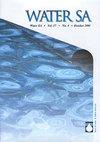南部非洲不同农业生态区降水时间趋势分析
IF 1.2
4区 环境科学与生态学
Q4 WATER RESOURCES
引用次数: 3
摘要
在雨养小农农业系统中,降雨是粮食生产的主要驱动力。本研究旨在评估(i)不同日降雨量(40 mm∙day-1)和(ii)月度和季节性降雨量的线性趋势。干旱是用降雨变率指数来确定的。每日降雨量数据来自南部非洲的18个气象站。日降雨量以40 mm day-1类型为主。半干旱区<5和5 - 10 mm∙day-1事件呈增加趋势。在降雨量减少的两个地点(1.24和3 mm∙season-1),季节降雨量呈显著的线性趋势。在半干旱条件下,季节性降雨量减少3 mm∙season-1。在研究的18个地点中,有15个地点的月和季降雨量没有明显的线性趋势。干旱频率因地而异,在11月至3月的生长期,干旱频率为50%或更高。降雨趋势与地点和农业生态有关,但大多数研究地点在1900年至2000年间没有发生显著变化。本文章由计算机程序翻译,如有差异,请以英文原文为准。
Temporal rainfall trend analysis in different agro-ecological regions of southern Africa
Rainfall is a major driver of food production in rainfed smallholder farming systems. This study was conducted to assess linear trends in (i) different daily rainfall amounts (<5, 5–10, 11–20, 21–40 and >40 mm∙day-1), and (ii) monthly and seasonal rainfall amounts. Drought was determined using the rainfall variability index. Daily rainfall data were derived from 18 meteorological stations in southern Africa. Daily rainfall was dominated by <5 mm∙day-1 followed by 5–10 mm∙day-1. Three locations experienced increasing linear trends of <5 mm∙day-1 amounts and two others in sub-humid region had increases in the >40 mm day-1 category. Semi-arid location experienced increasing trends in <5 and 5–10 mm∙day-1 events. A significant linear trend in seasonal rainfall occurred at two locations with decreasing rainfall (1.24 and 3 mm∙season-1). A 3 mm∙season-1 decrease in seasonal rainfall was experienced under semi-arid conditions. There were no apparent linear trends in monthly and seasonal rainfall at 15 of the 18 locations studied. Drought frequencies varied with location and were 50% or higher during the November–March growing season. Rainfall trends were location and agro-ecology specific, but most of the locations studied did not experience significant changes between the 1900s and 2000s.
求助全文
通过发布文献求助,成功后即可免费获取论文全文。
去求助
来源期刊

Water SA
环境科学-水资源
CiteScore
2.80
自引率
6.70%
发文量
46
审稿时长
18-36 weeks
期刊介绍:
WaterSA publishes refereed, original work in all branches of water science, technology and engineering. This includes water resources development; the hydrological cycle; surface hydrology; geohydrology and hydrometeorology; limnology; salinisation; treatment and management of municipal and industrial water and wastewater; treatment and disposal of sewage sludge; environmental pollution control; water quality and treatment; aquaculture in terms of its impact on the water resource; agricultural water science; etc.
Water SA is the WRC’s accredited scientific journal which contains original research articles and review articles on all aspects of water science, technology, engineering and policy. Water SA has been in publication since 1975 and includes articles from both local and international authors. The journal is issued quarterly (4 editions per year).
 求助内容:
求助内容: 应助结果提醒方式:
应助结果提醒方式:


